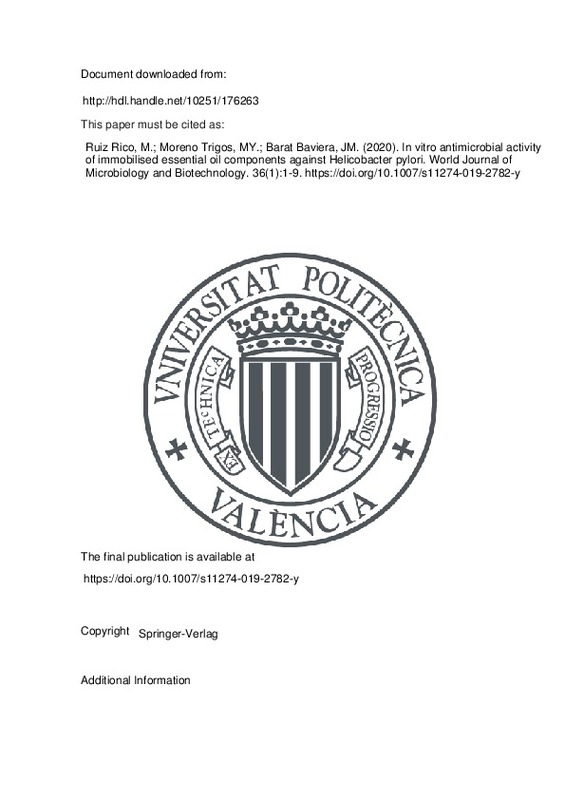Adams BL, Bates TC, Oliver JD (2003) Survival of Helicobacter pylori in a natural freshwater environment. Appl Environ Microbiol 69:7462–7466. https://doi.org/10.1128/AEM.69.12.7462-7466.2003
Ali S, Khan A, Ahmed I et al (2005) Antimicrobial activities of eugenol and cinnamaldehyde against the human gastric pathogen Helicobacter pylori. Ann Clin Microbiol Antimicrob 4:20. https://doi.org/10.1186/1476-0711-4-20
Altiok D, Altiok E, Tihminlioglu F (2010) Physical, antibacterial and antioxidant properties of chitosan films incorporated with thyme oil for potential wound healing applications. J Mater Sci Mater Med 21:2227–2236. https://doi.org/10.1007/s10856-010-4065-x
[+]
Adams BL, Bates TC, Oliver JD (2003) Survival of Helicobacter pylori in a natural freshwater environment. Appl Environ Microbiol 69:7462–7466. https://doi.org/10.1128/AEM.69.12.7462-7466.2003
Ali S, Khan A, Ahmed I et al (2005) Antimicrobial activities of eugenol and cinnamaldehyde against the human gastric pathogen Helicobacter pylori. Ann Clin Microbiol Antimicrob 4:20. https://doi.org/10.1186/1476-0711-4-20
Altiok D, Altiok E, Tihminlioglu F (2010) Physical, antibacterial and antioxidant properties of chitosan films incorporated with thyme oil for potential wound healing applications. J Mater Sci Mater Med 21:2227–2236. https://doi.org/10.1007/s10856-010-4065-x
Ardalan A, Vala MH, Sarie H et al (2017) Formulation and evaluation of food-grade antimicrobial cinnamon oil nanoemulsions for Helicobacter pylori eradication. J Bionanosci 11:435–441. https://doi.org/10.1166/jbns.2017.1463
Bergonzelli GE, Donnicola D, Porta N, Corthésy-Theulaz IE (2003) Essential oils as components of a diet-based approach to management of Helicobacter infection. Antimicrob Agents Chemother 47:3240–3246. https://doi.org/10.1128/AAC.47.10.3240-3246.2003
Bernardos A, Marina T, Žáček P et al (2015) Antifungal effect of essential oil components against Aspergillus niger when loaded into silica mesoporous supports. J Sci Food Agric 95:2824–2831. https://doi.org/10.1002/jsfa.7022
Burt S (2004) Essential oils: their antibacterial properties and potential applications in foods—a review. Int J Food Microbiol 94:223–253. https://doi.org/10.1016/J.IJFOODMICRO.2004.03.022
Burt SA, Vlielander R, Haagsman HP, Veldhuizen EJA (2005) Increase in activity of essential oil components carvacrol and thymol against Escherichia coli O157:H7 by addition of food stabilizers. J Food Prot 68:919–926. https://doi.org/10.4315/0362-028X-68.5.919
Cappannella E, Benucci I, Lombardelli C et al (2016) Immobilized lysozyme for the continuous lysis of lactic bacteria in wine: bench-scale fluidized-bed reactor study. Food Chem 210:49–55. https://doi.org/10.1016/J.FOODCHEM.2016.04.089
Chen F, Shi Z, Neoh KG, Kang ET (2009) Antioxidant and antibacterial activities of eugenol and carvacrol-grafted chitosan nanoparticles. Biotechnol Bioeng 104:30–39. https://doi.org/10.1002/bit.22363
CLSI (2018) Performance standards for antimicrobial susceptibility testing, 28th edn. CLSI, Wayne
Eusebi LH, Zagari RM, Bazzoli F (2014) Epidemiology of Helicobacter pylori infection. Helicobacter 19:1–5. https://doi.org/10.1111/hel.12165
Fuccio L, Laterza L, Zagari RM et al (2008) Treatment of Helicobacter pylori infection. BMJ 337:1454. https://doi.org/10.1136/bmj.a1454
García-Ríos E, Ruiz-Rico M, Guillamón JM et al (2018) Improved antimicrobial activity of immobilised essential oil components against representative spoilage wine microorganisms. Food Control 94:177–186. https://doi.org/10.1016/J.FOODCONT.2018.07.005
Gutierrez J, Rodriguez G, Barry-Ryan C, Bourke P (2008) Efficacy of plant essential oils against foodborne pathogens and spoilage bacteria associated with ready-to-eat vegetables: antimicrobial and sensory screening. J Food Prot 71:1846–1854. https://doi.org/10.4315/0362-028X-71.9.1846
Hoffmann F, Cornelius M, Morell J, Fröba M (2006) Silica-based mesoporous organic–inorganic hybrid materials. Angew Chem Int Ed 45:3216–3251. https://doi.org/10.1002/anie.200503075
Hyldgaard M, Mygind T, Meyer RL (2012) Essential oils in food preservation: mode of action, synergies, and interactions with food matrix components. Front Microbiol 3:1–24. https://doi.org/10.3389/fmicb.2012.00012
Kahraman MV, Bayramoğlu G, Kayaman-Apohan N, Güngör A (2007) α-Amylase immobilization on functionalized glass beads by covalent attachment. Food Chem 104:1385–1392. https://doi.org/10.1016/J.FOODCHEM.2007.01.054
Li L, Wang H (2013) Enzyme-coated mesoporous silica nanoparticles as efficient antibacterial agents in vivo. Adv Healthc Mater 2:1351–1360. https://doi.org/10.1002/adhm.201300051
Lv F, Liang H, Yuan Q, Li C (2011) In vitro antimicrobial effects and mechanism of action of selected plant essential oil combinations against four food-related microorganisms. Food Res Int 44:3057–3064. https://doi.org/10.1016/J.FOODRES.2011.07.030
Moreno Y, Ferrús MA, Alonso JL et al (2003) Use of fluorescent in situ hybridization to evidence the presence of Helicobacter pylori in water. Water Res 37:2251–2256. https://doi.org/10.1016/S0043-1354(02)00624-3
Moreno Y, Piqueres P, Alonso JL et al (2007) Survival and viability of Helicobacter pylori after inoculation into chlorinated drinking water. https://doi.org/10.1016/j.watres.2007.05.020
Nazzaro F, Fratianni F, De Martino L et al (2013) Effect of essential oils on pathogenic bacteria. Pharmaceuticals 6:1451–1474. https://doi.org/10.3390/ph6121451
Nilsson H-O, Blom J, Abu-Al-Soud W et al (2002) Effect of cold starvation, acid stress, and nutrients on metabolic activity of Helicobacter pylori. Appl Environ Microbiol 68:11–19. https://doi.org/10.1128/AEM.68.1.11-19.2002
Peng H, Xiong H, Li J et al (2010) Vanillin cross-linked chitosan microspheres for controlled release of resveratrol. Food Chem 121:23–28. https://doi.org/10.1016/J.FOODCHEM.2009.11.085
Piqueres P, Moreno Y, Alonso JL, Ferrús MA (2006) A combination of direct viable count and fluorescent in situ hybridization for estimating Helicobacter pylori cell viability. Res Microbiol 157:345–349. https://doi.org/10.1016/j.resmic.2005.09.003
Ribes S, Ruiz-Rico M, Pérez-Esteve É et al (2017) Eugenol and thymol immobilised on mesoporous silica-based material as an innovative antifungal system: application in strawberry jam. Food Control. https://doi.org/10.1016/j.foodcont.2017.06.006
Ruiz-Rico M, Pérez-Esteve É, Bernardos A et al (2017) Enhanced antimicrobial activity of essential oil components immobilized on silica particles. Food Chem. https://doi.org/10.1016/j.foodchem.2017.04.118
Ruiz-Rico M, Pérez-Esteve É, de la Torre C et al (2018) Improving the antimicrobial power of low-effective antimicrobial molecules through nanotechnology. J Food Sci. https://doi.org/10.1111/1750-3841.14211
Santiago P, Moreno Y, Ferrús MA (2015) Identification of viable Helicobacter pylori in drinking water supplies by cultural and molecular techniques. Helicobacter 20:252–259. https://doi.org/10.1111/hel.12205
Takeuchi H, Trang VT, Morimoto N et al (2014) Natural products and food components with anti-Helicobacter pylori activities. World J Gastroenterol 20:8971–8978. https://doi.org/10.3748/wjg.v20.i27.8971
Turek C, Stintzing FC (2013) Stability of essential oils: a review. Compr Rev Food Sci Food Saf 12:40–53. https://doi.org/10.1111/1541-4337.12006
Vesga F-J, Moreno Y, Ferrús MA et al (2018) Detection of Helicobacter pylori in drinking water treatment plants in Bogotá, Colombia, using cultural and molecular techniques. Int J Hyg Environ Health 221:595–601. https://doi.org/10.1016/J.IJHEH.2018.04.010
Villalonga R, Díez P, Sánchez A et al (2013) Enzyme-controlled sensing-actuating nanomachine based on Janus Au-mesoporous silica nanoparticles. Chem Eur J 19:7889–7894. https://doi.org/10.1002/chem.201300723
Wang Y-K, Kuo F-C, Liu C-J et al (2015) Diagnosis of Helicobacter pylori infection: current options and developments. World J Gastroenterol 21:11221–11235. https://doi.org/10.3748/wjg.v21.i40.11221
Wolf VG, Bonacorsi C, Raddi MSG et al (2017) Octyl gallate, a food additive with potential beneficial properties to treat Helicobacter pylori infection. Food Funct 8:2500–2511. https://doi.org/10.1039/C7FO00707H
[-]







![[Cerrado]](/themes/UPV/images/candado.png)


